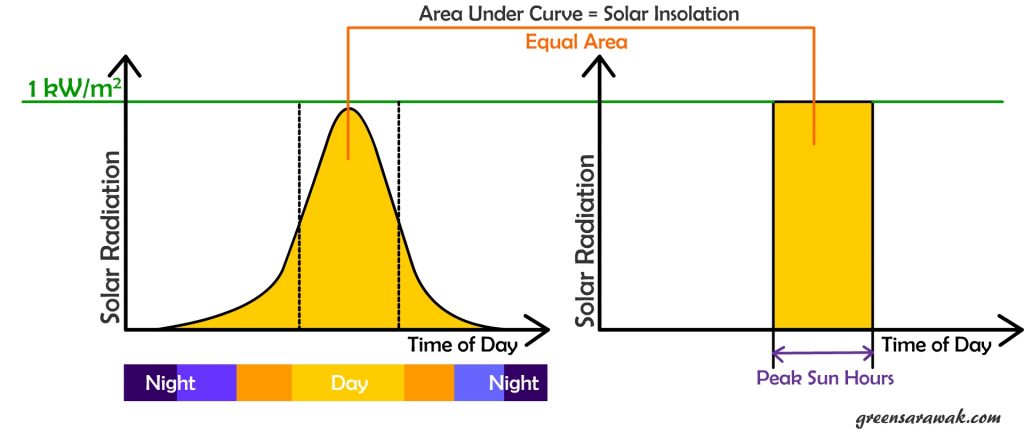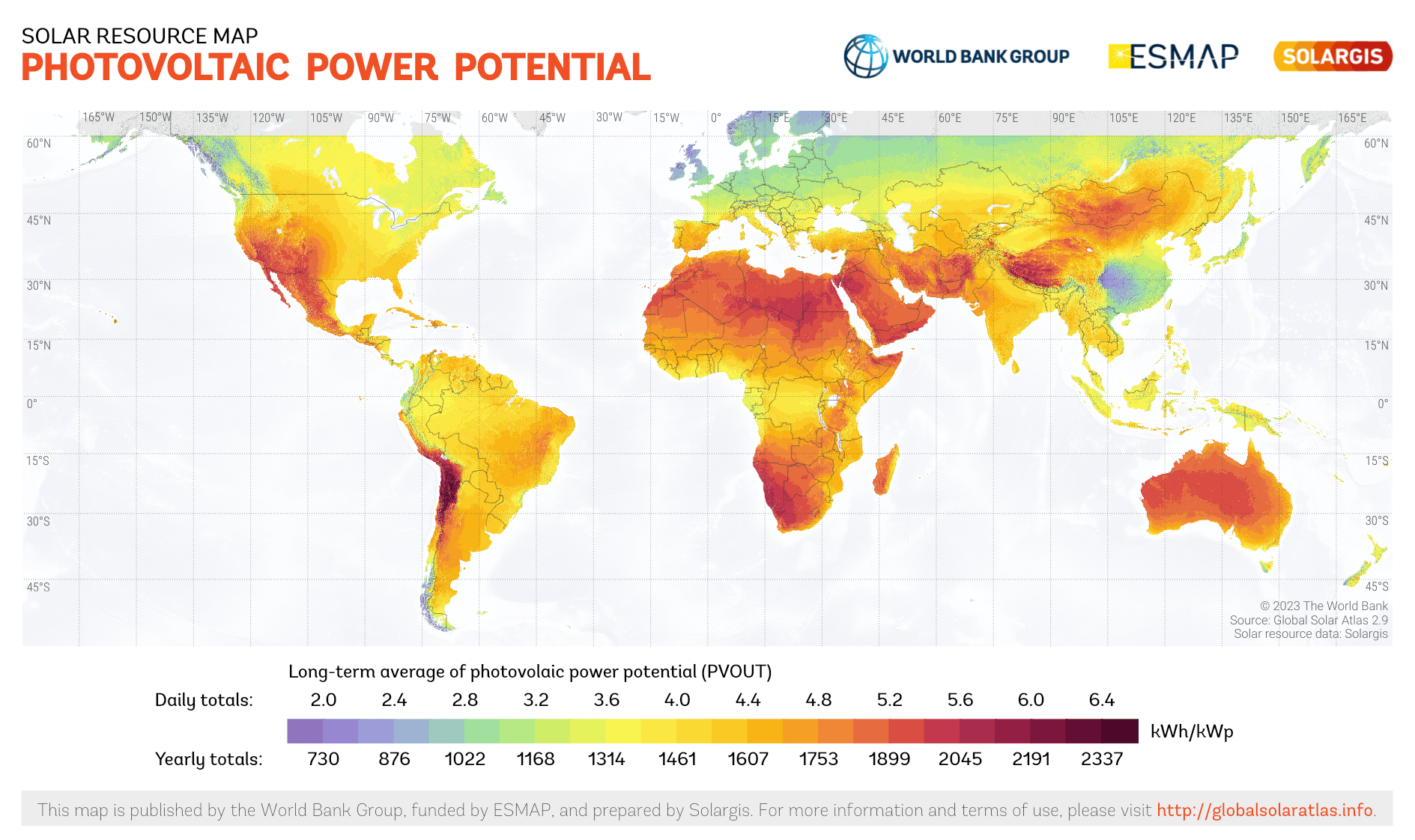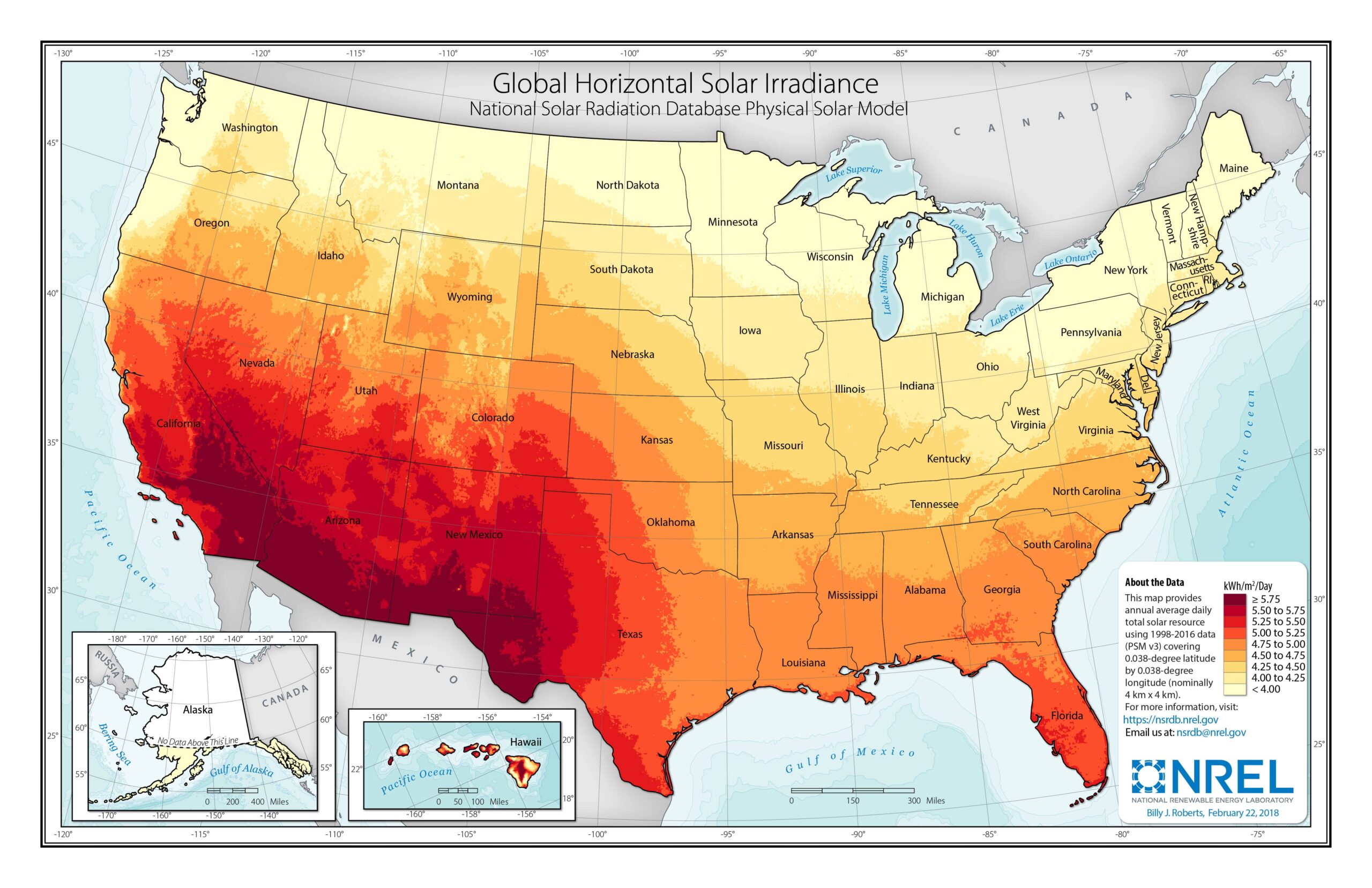What is a Peak Sun Hour?
A peak sun hour is defined as one hour when the intensity of sunlight reaches an average of 1,000 watts of energy per square meter (1,000 W/m²).
Peak Sun Hours vs. Solar Irradiance
Solar energy can be quantified in several ways, and two of the most common metrics are solar irradiance and peak sun hours.
Solar irradiance is typically measured in kilowatt-hours per square meter (kWh/m²) per day or year, giving us the total amount of solar energy received over a given time.
However, peak sun hours provide a more intuitive way to understand this data.
For example, if a location receives 5 kWh/m² per day, we can also say it experiences about 5 peak sun hours each day.
This measurement is particularly useful because it converts the abstract kWh/m² figures into something more relatable — hours of strong sunlight.
How Peak Sun Hours Measure Sunlight

The intensity of sunlight doesn’t remain constant throughout the day; it fluctuates based on the time and weather conditions.
For instance, early morning or late afternoon light is weaker, often under 500 W/m² per hour, while, around noon on a clear day, the intensity can exceed 1000 W/m².
We calculate the total solar irradiation in a given day by measuring the total area under the curve.
To make it simpler to understand, this area is transformed into a rectangle. The height of the rectangle is the maximum solar power received in a day, which is usually around noon when the sun intensity is 1 kW/m².
The width of the rectangle is the number of “Peak Sun Hours.”
This doesn’t mean the sun is only shining for these few hours; it means that the total energy the place gets all day is the same as if the maximum power from the sun shone for just these few hours.
To put it into perspective, if a location accumulates 5,350 Wh/m² of solar radiation in one day, this would equate to 5.35 peak sun hours or as if the sun intesnity was 1,000 W/m² for 5.35 hours.
Applications of Peak Sun Hours
1. Rating Solar Panels
When we talk about solar panels and their efficiency, it’s all about how well they convert sunlight into electricity.
To test a solar panel efficieny, we put it under a 1,000 W/m² artifical light that immitates the sun’s natural light and measure how much electricity it produces.
If the solar panel delivers 300 Wh of electricity during this test, we label it as a 300W panel, which basically means that for each peak sun hour the photovoltaic panel receives, it’ll generate approximately 300 Wh of electricity.
2. System Sizing
Peak sun hours are super handy when designing solar system.
By knowing how many hours of strong sunlight your area gets on average each day, you can choose the right number of panels to meet your energy needs using this simple formula:
Solar System Size = Daily Energy Needs / Average Peak Sun Hours per Day
It’s important to mention that this forumal doesn’t factor in solar system losses.
To get a real life estimation, you need to consider things like the roof orientation, array mismatch, inverter efficiency, and many other factors that usually make around 14%.
3. Energy Planning and Management
Utilities and energy planners use peak sun hours to predict how much power solar farms will contribute to the electricity grid.
This info is crucial for blending solar power with other types of energy and keeping the lights on without a hitch.
By understanding the flow of solar power throughout the day, they can ensure a stable and reliable energy supply for everyone.
4. Financial Analysis
If you’re thinking about getting into solar, peak sun hours can be your best friend in figuring out the bang for your buck.
In places with more peak sun hours, solar panels can generate more power. More power means faster savings on your energy bills, which helps offset the cost of your initial investment quicker.
Investors and homeowners use these numbers to crunch the return on investment, making sure solar panels not only lighten the environmental load but also lighten the load on their wallet.
Peak Sun Hours Maps
World Daily and Yearly Peak Sun Hours Map by Global Solar Atlas

US Peak Sun Hours Map by NREL

Peak Sun Hours by ZIP Code
Peak Sun Hours by State
Here’s the updated table including the average daily, monthly, and yearly peak sun hours for each state:
| State | Avg Daily Peak Hours | Avg Monthly Peak Hours | Avg Yearly Peak Hours |
|---|---|---|---|
| Alabama | 4.95 | 148.5 | 1806.75 |
| Alaska | 2.1 | 63.0 | 766.5 |
| Arizona | 7.5 | 225.0 | 2737.5 |
| Arkansas | 4.95 | 148.5 | 1806.75 |
| California | 6.25 | 187.5 | 2281.25 |
| Colorado | 6.0 | 180.0 | 2190.0 |
| Connecticut | 4.7 | 141.0 | 1715.5 |
| Delaware | 4.7 | 141.0 | 1715.5 |
| Florida | 5.45 | 163.5 | 1989.25 |
| Georgia | 4.95 | 148.5 | 1806.75 |
| Hawaii | 5.75 | 172.5 | 2098.75 |
| Idaho | 5.0 | 150.0 | 1825.0 |
| Illinois | 4.55 | 136.5 | 1660.75 |
| Indiana | 4.2 | 126.0 | 1533.0 |
| Iowa | 4.2 | 126.0 | 1533.0 |
| Kansas | 5.7 | 171.0 | 2080.5 |
| Kentucky | 4.45 | 133.5 | 1624.25 |
| Louisiana | 4.95 | 148.5 | 1806.75 |
| Maine | 4.2 | 126.0 | 1533.0 |
| Maryland | 4.7 | 141.0 | 1715.5 |
| Massachusetts | 4.7 | 141.0 | 1715.5 |
| Michigan | 4.2 | 126.0 | 1533.0 |
| Minnesota | 4.4 | 132.0 | 1606.0 |
| Mississippi | 4.95 | 148.5 | 1806.75 |
| Missouri | 4.95 | 148.5 | 1806.75 |
| Montana | 4.95 | 148.5 | 1806.75 |
| Nebraska | 5.45 | 163.5 | 1989.25 |
| Nevada | 6.75 | 202.5 | 2463.75 |
| New Hampshire | 4.25 | 127.5 | 1551.25 |
| New Jersey | 4.25 | 127.5 | 1551.25 |
| New Mexico | 6.75 | 202.5 | 2463.75 |
| New York | 4.25 | 127.5 | 1551.25 |
| North Carolina | 4.95 | 148.5 | 1806.75 |
| North Dakota | 4.95 | 148.5 | 1806.75 |
| Ohio | 4.2 | 126.0 | 1533.0 |
| Oklahoma | 5.7 | 171.0 | 2080.5 |
| Oregon | 4.95 | 148.5 | 1806.75 |
| Pennsylvania | 4.45 | 133.5 | 1624.25 |
| Rhode Island | 4.7 | 141.0 | 1715.5 |
| South Carolina | 4.95 | 148.5 | 1806.75 |
| South Dakota | 5.2 | 156.0 | 1898.0 |
| Tennessee | 4.7 | 141.0 | 1715.5 |
| Texas | 5.75 | 172.5 | 2098.75 |
| Utah | 6.2 | 186.0 | 2263.0 |
| Vermont | 4.2 | 126.0 | 1533.0 |
| Virginia | 4.45 | 133.5 | 1624.25 |
| Washington | 3.75 | 112.5 | 1368.75 |
| West Virginia | 4.2 | 126.0 | 1533.0 |
| Wisconsin | 4.45 | 133.5 | 1624.25 |
| Wyoming | 5.45 | 163.5 | 1989.25 |
Using Peak Sun Hours to Measure Solar System Output
To estimate the real-life output of a solar system, you can use the formula:
Real Life Output = System Size * Peak Sun Hours – System Losses.
Losses may include factors like shading, tilt angles, and efficiency losses in both the DC (direct current) and AC (alternating current) components of the system.
Let’s say you have a 7 kW solar panel system installed in a region that averages about 4.5 peak sun hours per day.
Assuming minimal system losses, your daily energy output might be close to 30 kWh per day, enough to power the average American home.
Conclusion
Understanding peak sun hours is not just academic; it’s a practical way to gauge and maximize the effectiveness of solar energy systems.
By applying the concept of peak sun hours, homeowners and businesses can better plan and optimize their solar installations, ensuring they harness the sun’s power most efficiently.
Remember, more sunlight means more energy, and understanding how to measure and maximize sunlight exposure is key to leveraging solar power to its fullest potential.
